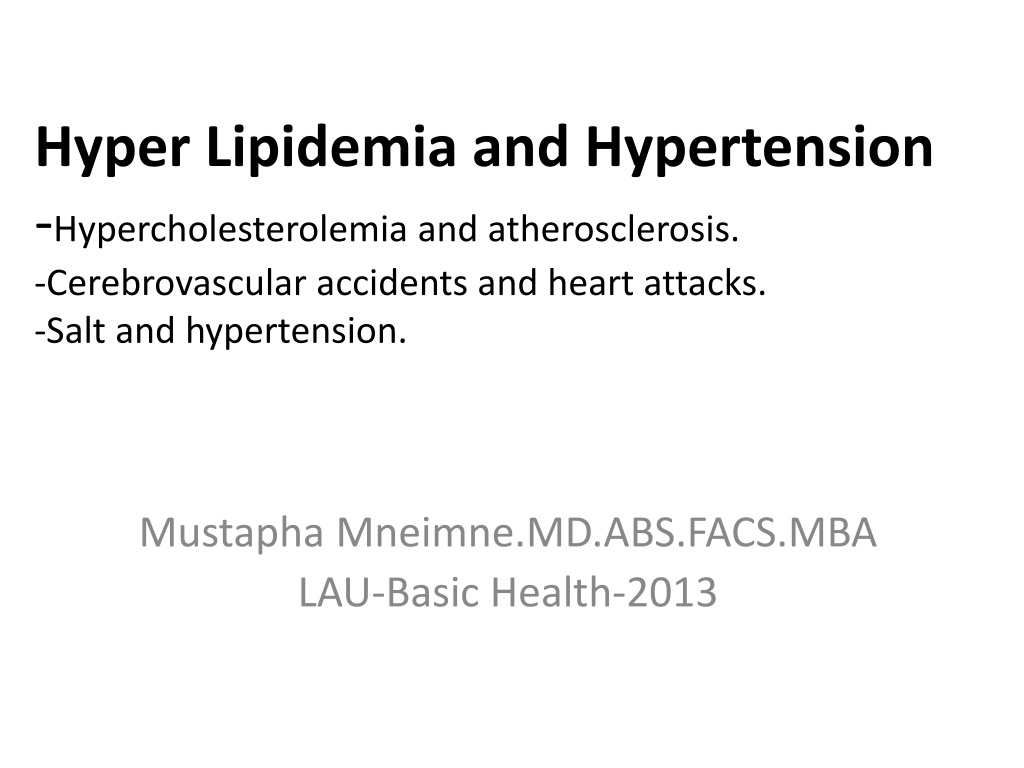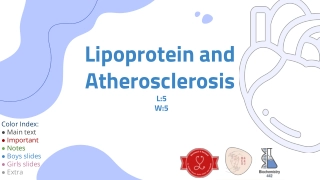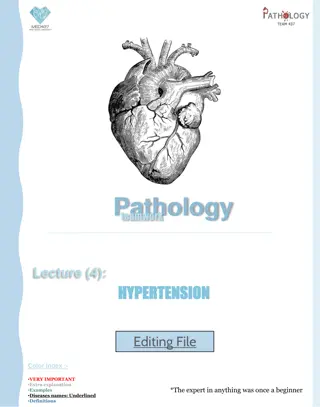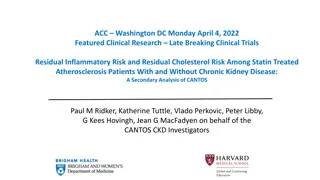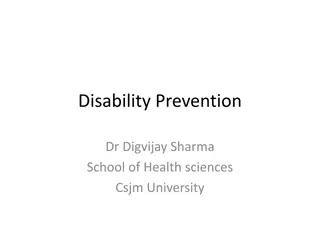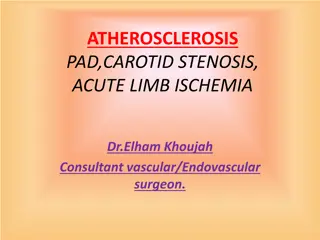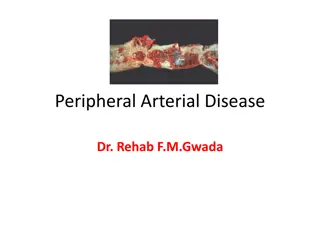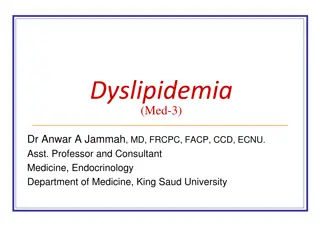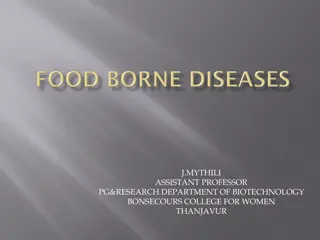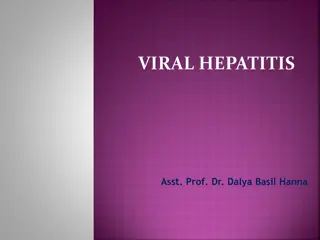Understanding Atherosclerosis: Causes, Symptoms, and Prevention
Arteriosclerosis and atherosclerosis are common cardiovascular conditions that involve the hardening and narrowing of arteries due to plaque buildup. Atherosclerosis specifically refers to the accumulation of fats and cholesterol in artery walls, leading to restricted blood flow and potential complications like heart attacks and strokes. Risk factors include high blood pressure, high cholesterol, diabetes, obesity, smoking, and a family history of heart disease. Recognizing symptoms and adopting a healthy lifestyle can help prevent and manage atherosclerosis.
Download Presentation

Please find below an Image/Link to download the presentation.
The content on the website is provided AS IS for your information and personal use only. It may not be sold, licensed, or shared on other websites without obtaining consent from the author. Download presentation by click this link. If you encounter any issues during the download, it is possible that the publisher has removed the file from their server.
E N D
Presentation Transcript
Hyper Lipidemia and Hypertension -Hypercholesterolemia and atherosclerosis. -Cerebrovascular accidents and heart attacks. -Salt and hypertension. Mustapha Mneimne.MD.ABS.FACS.MBA LAU-Basic Health-2013
Arteriosclerosis / atherosclerosis Definition Arteries are blood vessels that carry oxygen and nutrients from the heart to the rest of the body. Healthy arteries are flexible and elastic. Over time, however, too much pressure in these arteries can make the walls thick and stiff sometimes restricting blood flow to organs and tissues. This process is called arteriosclerosis, or hardening of the arteries.
Arteriosclerosis / atherosclerosis, Contd Atherosclerosis is a specific type of arteriosclerosis, but the terms are sometimes used interchangeably. Atherosclerosis refers to the buildup of fats and cholesterol in and on the artery walls (plaques), which can restrict blood flow. These plaques can also burst, triggering a blood clot. Although atherosclerosis is often considered a heart problem, it can affect arteries anywhere in your body. Atherosclerosis is a preventable and treatable condition.
Atherosclerosis: Symptoms Symptoms develops gradually. Mild atherosclerosis usually doesn't have any symptoms. atherosclerosis symptoms usually won't appear until an artery is so narrowed or clogged that it can't supply adequate blood to the organs and tissues. Sometimes a blood clot completely blocks blood flow, or even breaks apart and can trigger a heart attack or stroke. Symptoms of moderate to severe atherosclerosis depend on which arteries are affected.
Causes Atherosclerosis is a slow, progressive disease that may begin as early as childhood. Although the exact cause is unknown, atherosclerosis may start with damage or injury to the inner layer of an artery. The damage may be caused by: High blood pressure High cholesterol, often from getting too much cholesterol or saturated fats in your diet Smoking Diabetes
Risk factors for Atherosclerosis Factors that increase the risk of atherosclerosis include: High blood pressure High cholesterol Diabetes Obesity Smoking A family history of early heart disease
Complications of atherosclerosis depend on the location of the blocked Coronary artery disease. CAD which can cause chest pain (angina), a heart attack or heart failure. Carotid artery disease. (brain blood supply) which can cause a transient ischemic attack (TIA) or stroke. Peripheral artery disease. Narrowing of the arteries in arms or legs.pain upon walking may be the first sign of the diesease. Claudication . Aneurysms. Atherosclerosis can also cause aneurysms, a serious complication that can occur anywhere in the body. An aneurysm is a bulge in the wall of your artery. Most people with aneurysms have no symptoms. Pain and throbbing in the area of an aneurysm may occur and is a medical emergency. If an aneurysm bursts ,life-threatening internal bleeding occurs .
Prevention Lifestyle changes can help you prevent or slow the progression of atherosclerosis. Stop smoking. Smoking damages arteries. Quitting is the best way to halt the progression of atherosclerosis and reduce the risk of complications. Exercise most days of the week. Regular exercise can condition your muscles to use oxygen more efficiently. Physical activity can also improve circulation and promote development of new blood vessels that form a natural bypass around obstructions (collateral vessels). Exercise helps lower blood pressure and reduce your risk of diabetes. Ideally, exercise should be 30 to 60 minutes most days of the week. Eat healthy foods. A heart-healthy diet based on fruits, vegetables and whole grains and low in saturated fat, cholesterol and sodium can help you control weight, blood pressure, cholesterol and blood sugar. Lose extra weight and maintain a healthy weight. Weight reduction can help reduce your risk of high blood pressure and high cholesterol, two of the major risk factors for developing atherosclerosis. Manage stress. Reduce stress as much as possible. Practice healthy techniques for managing stress, such as muscle relaxation and deep breathing.
Alternative medicine in controlling atherosclerosis It's thought that some foods and herbal supplements can help reduce high cholesterol level and high blood pressure, two major risk factors for developing atherosclerosis. Alpha-linolenic acid (ALA) Artichoke Barley Blond psyllium (found in seed husk and products such as Metamucil) Calcium Cocoa Cod liver oil Coenzyme Q10 Garlic Oat bran (found in oatmeal and whole oats) Omega-3 fatty acids Sitostanol (found in oral supplements and some margarines. Relaxation techniques can temporarily lower blood pressure, and thus reduce the risk of developing atherosclerosis.
Conclusion Atherosclerosis is inevitable. However slowing the progress will prevent the risk of complications: Heart attack, stroke and hypertension. Prevention is the best way to control atherosclerosis: Quitting smoking Eating healthy foods(low salt,low carbs & low fats). Exercising regularly Maintaining a healthy weight
Hypertension Introduction and Definition High blood pressure is a common condition in which the force of the blood against artery walls is high enough that it may eventually cause health problems, such as heart disease. Blood pressure is determined by the amount of blood the heart pumps and the amount of resistance to blood flow in the arteries. The more blood heart pumps and the narrower the arteries, the higher the blood pressure. Uncontrolled high blood pressure increases the risk of serious health problems, including heart attack and stroke.
Hypertension: Introduction and Definition Contd High blood pressure typically develops over many years, and it affects nearly everyone eventually. Fortunately, high blood pressure can be easily detected. And once it is diagnosed, patients will be on antihypertension drugs for life along with certain life style changes. Hypertension is defined as elevation of blood pressure above 120/80 mmHg.
Hypertension: Symptoms Most people with high blood pressure have no signs or symptoms, even if blood pressure readings reach dangerously high levels. Although a few people with early-stage high blood pressure may have dull headaches, dizzy spells or a few more nosebleeds than normal, these signs and symptoms typically don't occur until high blood pressure has reached a severe even life- threatening stage. Sometimes heart attack or stroke may be the presenting
Hypertension: Primary (essential) hypertension For most adults, there's no identifiable cause of high blood pressure. This type of high blood pressure, called essential hypertension or primary hypertension, tends to develop gradually over many years. Secondary hypertension Some people have high blood pressure caused by an underlying condition. This type of high blood pressure, called secondary hypertension, tends to appear suddenly and cause higher blood pressure than does primary hypertension. Various conditions and medications can lead to secondary hypertension, including: Kidney problems Adrenal gland tumors Certain defects in blood vessels you're born with (congenital) Certain medications, such as birth control pills, cold remedies, decongestants, over-the-counter pain relievers and some prescription drugs Illegal drugs, such as cocaine and amphetamines
Risk factors Age. The risk of high blood pressure increases with age. Through early middle age, high blood pressure is more common in men. Women are more likely to develop high blood pressure after menopause. Race. High blood pressure is particularly common among blacks. Family history. High blood pressure tends to run in families. Being overweight or obese. The more the weight, the more blood needed to supply oxygen and nutrients to tissues. Sedentary life. Tobacco. Chemicals in tobacco can damage the lining of artery walls. Secondhand smoke also can increase your blood pressure. Too much salt (sodium) in your diet. Too much sodium in your diet can cause your body to retain fluid, which increases blood pressure.
Risk factors contd Too little potassium in your diet. Potassium helps balance the amount of sodium in cells. Drinking too much alcohol. Over time, heavy drinking can damage the heart. Having more than two drinks a day can raise blood pressure. Stress. High levels of stress can lead to a temporary, but dramatic, increase in blood pressure. Certain chronic conditions. Certain chronic conditions also may increase the risk of high blood pressure, including high cholesterol, diabetes, kidney disease and sleep apnea. Sometimes pregnancy contributes to high blood pressure.(Gestational hypertension).
Complications of high blood pressure Uncontrolled high blood pressure can lead to: Heart attack or stroke. Aneurysm. Heart failure. To pump blood against the higher pressure in the vessels, the heart muscle thickens. Eventually, the thickened muscle may have a hard time pumping enough blood to meet your body's needs, which can lead to heart failure. Weakened and narrowed blood vessels in the kidneys. This can prevent these organs from functioning normally. Thickened, narrowed or torn blood vessels in the eyes. This can result in vision loss. Metabolic syndrome. This syndrome is a cluster of disorders of body's metabolism including increased waist circumference, high triglycerides, low high-density lipoprotein (HDL), or "good," cholesterol, high blood pressure, and high insulin levels. Trouble with memory or understanding. Uncontrolled high blood pressure may also affect the ability to think, remember and learn. *Trouble with memory or understanding concepts is more common in people who have high blood pressure.*
Blood pressure measurements and stages Blood pressure is measured with an inflatable arm cuff and a pressure- measuring gauge. A blood pressure reading, given in millimeters of mercury (mm Hg), has two numbers. The first, or upper, number measures the pressure in the arteries when the heart beats (systolic pressure). The second, or lower, number measures the pressure in the arteries between beats (diastolic pressure).(heart filling). Blood pressure measurements fall into four general categories: 1- Normal blood pressure. Blood pressure is normal if it's below 120/80 mm Hg. 2- Prehypertension. Prehypertension is a systolic pressure ranging from 120 to 139 mm Hg or a diastolic pressure ranging from 80 to 89 mm Hg. Prehypertension tends to get worse over time. 3- Stage 1 hypertension. Stage 1 hypertension is a systolic pressure ranging from 140 to 159 mm Hg or a diastolic pressure ranging from 90 to 99 mm Hg. 4- Stage 2 hypertension. More severe hypertension, stage 2 hypertension is a systolic pressure of 160 mm Hg or higher or a diastolic pressure of 100 mm Hg or higher.
Prevention and control of hypertension Lifestyle and home remedies Eating healthy foods. The Dietary Approaches to Stop Hypertension (DASH) diet, which emphasizes fruits, vegetables, whole grains and low-fat dairy foods. Plenty of potassium, which can help prevent and control high blood pressure. less saturated fat and total fat. Decrease the salt in diet. A lower sodium level 1,500 milligrams (mg) a day is appropriate for people 51 years of age or older, and individuals of any age who are African-American or who have hypertension, diabetes or chronic kidney disease. Otherwise healthy people can aim for 2,300 mg a day or less. While you can reduce the amount of salt you eat by putting down the saltshaker, you should also pay attention to the amount of salt that's in the processed foods you eat, such as canned soups or frozen dinners. Maintain a healthy weight. Increase physical activity. Regular physical activity can help lower your blood pressure and keep your weight under control. Strive for at least 30 minutes of physical activity a day. Limit alcohol. Even if you're healthy, alcohol can raise your blood pressure. Quitting smoking. Manage stress. Reduce stress as much as possible. Practice healthy coping techniques, such as muscle relaxation and deep breathing. Getting plenty of sleep can help, too. Monitor blood pressure at home. Home blood pressure monitoring can help keep closer look on blood pressure, show if medication is working
Alternative medicine & Hypertension Although diet and exercise are the best tactics to lower your blood pressure, some supplements also may help decrease it. These include: Alpha-linolenic acid Blond psyllium Calcium Cocoa Cod-liver oil Coenzyme Q10 Omega-3 fatty acids Garlic
Salt and hypertension: is salt dietary reduction worth the effort? In numerous epidemiologic, clinical, and experimental studies, dietary sodium intake has been linked to blood pressure, and a reduction in dietary salt intake has been documented to lower blood pressure. In young subjects, salt intake has a programming effect in that blood pressure remains elevated even after a high salt intake has been reduced. Elderly subjects, African Americans, and obese patients are more sensitive to the blood pressure-lowering effects of a decreased salt intake. A greater decrease in blood pressure is achieved when a reduced salt intake is combined with other lifestyle interventions, such as adherence to Dietary Approaches to Stop Hypertension. A high salt intake has been shown to increase not only blood pressure but also the risk of stroke, left ventricular hypertrophy, and proteinuria. Dietary salt intake reduction can delay or prevent the incidence of antihypertensive therapy, can facilitate blood pressure reduction in hypertensive patients receiving medical therapy, and may represent a simple cost-saving mediator to reduce cardiovascular morbidity and mortality. Am J Med. 2012 May;125(5):433-9. doi: 10.1016/j.amjmed.2011.10.023
References www.mayoclinic.com http://www.ncbi.nlm.nih.gov U.S. National Library of Medicine - The World's Largest Medical Library Am J Med. 2012 May;125(5):433-9. doi: 10.1016/j.amjmed.2011.10.023 The Merck Manual Home Health Handbook Online Version
